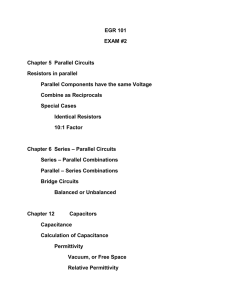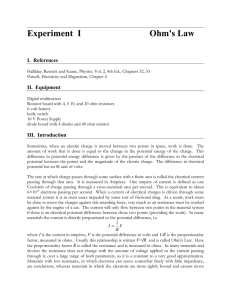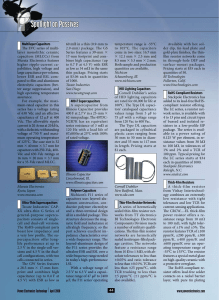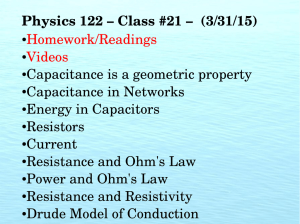Unit 14.2 Resistors and DC Circuits
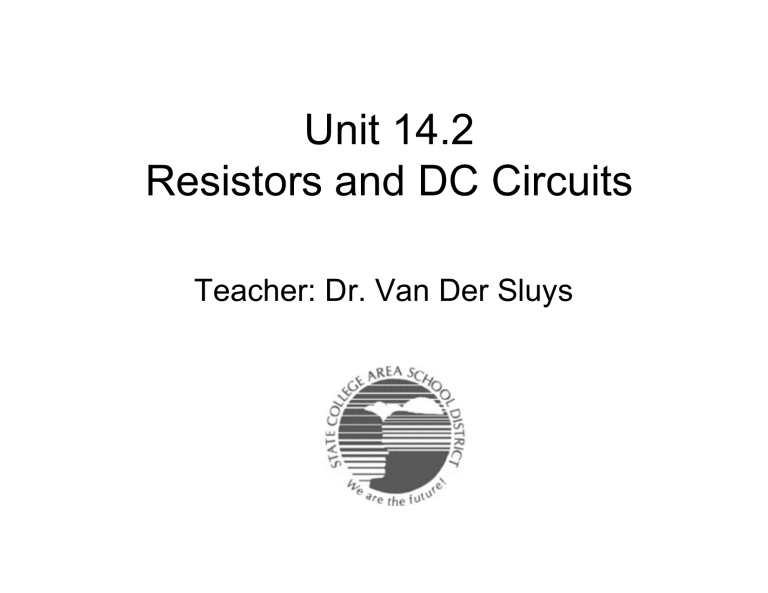
Unit 14.2
Resistors and DC Circuits
Teacher: Dr. Van Der Sluys
• Ohm’s Law
• Resistors
• DC Circuits
– Series
– Parallel
• Capacitors
– Series
– Parallel
• RC Circuits
Objectives
Ohm’s Law
V = IR
V = voltage drop
I = current in amperes
R = resistance, a constant for the device measured in Ohms ( Ω )
Resistors
A resistor is a two-terminal electrical or electronic component that opposes an electric current by producing a voltage drop between its terminals in accordance with Ohm's law: V =
I R The electrical resistance is equal to the voltage drop across the resistor divided by the current through the resistor while the temperature remains the same. Resistors are used as part of electrical networks and electronic circuits.
http://en.wikipedia.org/wiki/Resistor
Examples
• What voltage must be applied to a 100
Ω resistor to achieve a current of 2.5
amps?
• What current flows through a circuit when a voltage of 110 V is applied to a
20 Ω resistor?
• If 25 V is required to produce a current of 2.0 amps in a circuit, what is the resistance of the circuit?
Color
Black
Brown
Red
Orange
Yellow
Green
Blue
Violet
Gray
White
Gold
Silver
1 st band
2
3
4
0
1
5
6
7
8
9
2 nd band
2
3
4
0
1
5
6
7
8
9
3 rd band
Multiplier x 10 0 x 10 1 x 10 2 x 10 3 x 10 4 x 10 5 x 10 6 x 10 7 x 10 8 x 10 9 x 10 -1 x 10 -2
4 th band
Tolerence
±1 %
±2 %
±0.5%
±0.25 %
±0.1 %
±0.05 %
±5 %
±10 %
Direct Current Versus
Alternating Current
• Direct current (DC or "continuous current") is the unidirectional flow of electric charge. Direct current is produced by such sources as batteries, thermocouples, solar cells, and commutator-type electric machines of the dynamo type.
• An alternating current (AC) is an electric current of which magnitude and direction vary. That is the difference to direct current, whose direction remains constant.
http://en.wikipedia.org/wiki/Direct_current http://simple.wikipedia.org/wiki/Alternating_current
Power supply
A DC Circuit switch
100
Ω resistor
Equivalent Resistance -
Resistors in Series
R
T
= R
1
+ R
2
…
50
Ω
100
Ω
100
Ω
Equivalent Resistance -
Paralell Resistors
R
T
= +
1
R
2
…
100
Ω
100
Ω
Example: What is the equivalent resistance?
50
Ω
100
Ω
100
Ω
100
Ω
Example: What is the equivalent resistance?
50
Ω
25
Ω
100
Ω
100
Ω
100
Ω
50
Ω
Example: What is the equivalent resistance?
50
Ω
25
Ω
50
Ω 25
Ω
50
Ω
125
Ω
50
Ω
Capacitors
A capacitor is an electrical/electronic device that can store energy in the electric field between a pair of conductors (called "plates").
The process of storing energy in the capacitor is known as "charging", and involves electric charges of equal magnitude, but opposite polarity, building up on each plate. Capacitors are often used in electric and electronic circuits as energy-storage devices.
Capacitance
The capacitor's capacitance (C) is a measure of the amount of charge (Q) stored on each plate for a given potential difference or voltage (V) which appears between the plates:
In SI units, a capacitor has a capacitance of one farad when one coulomb of charge is stored due to one volt applied potential difference across the plates.
Capacitance is measure in Farads.
Equivalent Capacitance:
Capacitors in Series and Paralell
• Series
• Paralell
C
T
C
1
+ C
2
C
T
= C
1
+ C
2
….
Example: What is the equivalent capacitance in terms of C?
C
4 C 3 C



